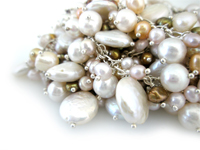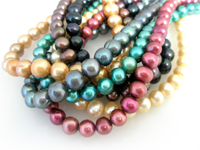 |
|
Pearl A pearl is a hard, sometimes roundish object produced within the soft tissue of a living shelled mollusk. Just like the shell of mollusks, a pearl is composed of calcium carbonate in minute crystalline form, which has been deposited in concentric layers. The ideal pearl is perfectly round and smooth, but many other shapes of pearls occur. The finest quality natural pearls have been highly valued as gemstones and objects of beauty for many centuries, and because of this, the word pearl became a metaphor for something very rare, very fine, very admirable and very valuable. Valuable pearls occur in the wild, but they are very rare. Cultured or farmed pearls make up the majority of those that are currently sold especially when it comes to jewelry. The pearls are usually harvested after one year for akoya, 2-4 years for Tahitian and South Sea, and 2-7 years for freshwater. In addition, cultured freshwater pearls can be dyed yellow, green, blue, brown, pink, purple, or black. Pearls from the sea are valued more highly than freshwater pearls. Pearls have been harvested, or more recently cultivated, primarily for use in jewelry, but in the past they were also stitched onto lavish clothing, as worn, for example, by royalty. Pearls have also been crushed and used in cosmetics, medicines, or in paint formulations. The value of the pearls in jewelry is determined by a combination of the luster, color, size, lack of surface flaw and symmetry that are appropriate for the type of pearl under consideration. Among those attributes, luster is the most important differentiator of pearl quality according to jewelers. For thousands of years, most seawater pearls were retrieved by divers working in the Indian Ocean, in areas like the Persian Gulf, the Red Sea, and in the Gulf of Mannar. Starting in the Han Dynasty (206 BC - 220 AD), the Chinese hunted extensively for seawater pearls in the South China Sea. When Spanish conquistadors arrived in the Western Hemisphere, they discovered that around the islands of Cubaguaand Margarita, some 200 km It signifies faith, charity and innocence enhances personal integrity and helps to provide a focus to ones attention. It also symbolizes purity and can stimulate that condition in both one's body and mind; hence, providing a clear vehicle for the advancing states of wisdom as well as clean channel for receipt of spiritual guidance. The pearl has been known as a stone of sincerity, bringing truth to situation and loyalty to a cause. It has also been used to inhibit boisterous behavior and to provide a reflection of the self such that one may see the manner in which one appears to others. |
|
|
Desert Rosing Trading. All Rights Reserved.


